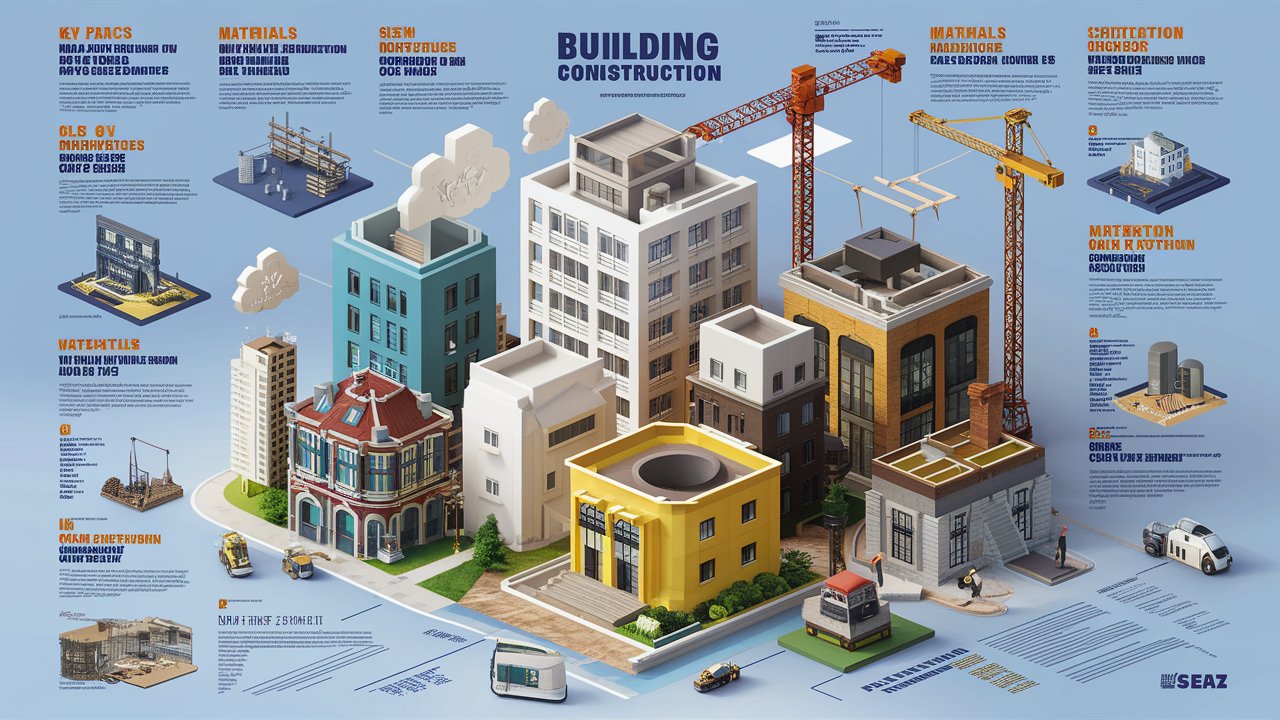Introduction
Building constructions are the foundation of human civilization. Buildings, from ancient marvels to towering skyscrapers, show human growth and creativity. This article explores several elements of construction, including history, materials, design, safety, and future developments.
History of Building
Ancient Construction Techniques
Ancient civilizations demonstrated amazing inventiveness via their construction technologies. The Egyptians built the pyramids using basic equipment and a large work force. The Romans brought concrete and arches, which revolutionized architecture and allowed for the creation of gigantic monuments such as the Colosseum.
Changes Throughout Centuries
Building techniques have changed greatly over the decades. Gothic architecture, with its pointed arches and flying buttresses, rose to prominence during the Middle Ages. The utilization of steel and reinforced concrete throughout the Industrial Revolution resulted in the building of skyscrapers and contemporary infrastructure.
Building Materials

Conventional Materials
In the past, clay, stone, and wood were the most common building materials. These easily obtained materials gave early buildings the strength and longevity they needed.
Contemporary Materials
Many materials, such as steel, concrete, glass, and composites, are used in structures today. Taller buildings and creative designs are made possible by the improved strength, flexibility, and aesthetic appeal of these materials.
Eco-Friendly Construction Materials
Sustainable materials like bamboo, repurposed steel, and rammed earth are growing more and more fashionable as environmental concerns develop. These materials encourage sustainability and lessen the environmental impact of building projects.
The Evolving Tapestry of Human Habitat
From humble abodes to towering metropolises, structures have been the canvas upon which human civilization has painted its story. The purpose and form of buildings have evolved in tandem with societal needs, technological advancements, and aesthetic sensibilities.
Residential Realms
Designed to shelter and nurture, residential structures range from solitary havens to bustling communal spaces. Houses, apartments, and condominiums cater to diverse lifestyles, reflecting personal preferences and economic realities. Factors like location, climate, and cultural influences shape their design and construction.
Commercial Corridors
The heartbeat of commerce, commercial buildings are dynamic spaces where goods and services are exchanged. Offices, retail establishments, and hospitality venues must balance functionality with visual appeal to attract customers and employees. Sustainable design and accessibility have become paramount in modern commercial architecture.
Industrial Infrastructure
Powerhouses of production, industrial buildings are characterized by their robust construction and efficient layout. Factories, warehouses, and manufacturing plants demand structures that can withstand heavy machinery, optimize workflow, and ensure safety. The integration of technology is transforming these spaces into intelligent, interconnected hubs.
Civic Centers
Serving as community anchors, public buildings embody civic values and aspirations. Schools, hospitals, government offices, and cultural institutions require careful planning to meet the needs of diverse populations. Accessibility, security, and energy efficiency are critical considerations.
The Art and Science of Building
Architecture is both an art and a science, demanding a harmonious blend of aesthetics and engineering. Skilled architects and engineers collaborate to create structures that are functional, visually compelling, and responsive to their environment. Iconic buildings, such as the Sydney Opera House and the Burj Khalifa, exemplify the power of human ingenuity.
Regulations and Realities
Building codes and regulations are the framework within which structures are erected. These guidelines ensure public safety, accessibility, and environmental protection. Adherence to these standards is essential for preventing disasters and fostering sustainable development.
Construction Chronicles
The journey from concept to completion is a complex process involving meticulous planning, skilled labor, and advanced technology. Site preparation, foundation laying, structural framing, and finishing are key stages in the construction lifecycle. Project management, cost control, and quality assurance are critical for success.
Safety First
The well-being of workers and occupants is paramount. Implementing robust safety protocols, providing proper training, and using protective equipment are essential for preventing accidents and injuries. Regular inspections and maintenance contribute to a safe and healthy built environment.
Innovation and Sustainability
The construction industry is undergoing a transformative shift driven by technological advancements and environmental concerns. Building Information Modeling (BIM), 3D printing, and drones are revolutionizing design and construction processes. Sustainable materials, energy-efficient systems, and renewable energy sources are shaping the future of architecture.
Challenges and Opportunities
The building sector faces numerous challenges, including economic fluctuations, labor shortages, and climate change. However, these challenges also present opportunities for innovation and adaptation. By embracing sustainable practices, adopting emerging technologies, and fostering collaboration, the industry can build a better future.
Conclusion
Buildings are more than mere structures; they are reflections of human society, culture, and aspirations. As we navigate the complexities of the 21st century, the built environment will continue to evolve, driven by innovation, sustainability, and a commitment to human well-being.
FAQs
What effects do building codes have on construction?
Building codes have an impact on building by establishing requirements for accessibility, quality, and safety. Adherence to these requirements guarantees both the safety of the building’s residents and its structural soundness.
What advantages does sustainable construction offer?
Better occupant health, fewer energy costs, and a smaller environmental effect are all advantages of sustainable building. Additionally, sustainable structures typically have longer lifespans and better property values.
What are some well-known architects’ names and noteworthy projects?
Notable architects include Le Corbusier (Villa Savoye), Zaha Hadid (London Aquatics Centre), and Frank Lloyd Wright (Fallingwater). Their avant-garde designs have had a big impact on contemporary architecture.
Which breakthroughs will influence construction in the future?
Sustainable materials, smart technologies, and 3D printing are some of the innovations reshaping the building industry.These developments are encouraging environmental sustainability, cutting costs, and improving construction efficiency.



